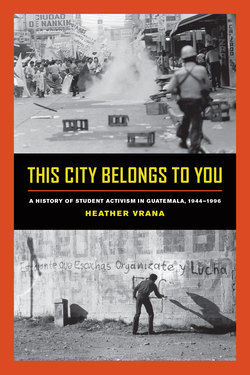This City Belongs to You

Реклама. ООО «ЛитРес», ИНН: 7719571260.
Оглавление
Heather Vrana. This City Belongs to You
Отрывок из книги
This City Belongs to You
A HISTORY OF STUDENT ACTIVISM
.....
Even as the university enrolled greater numbers of people, it remained a place for a small number of ladino men. University enrollments increased more than 450 percent during the revolution and they decreased very little after the counterrevolution to 3,245 from 3,368 between 1954 and 1955. The following year, enrollments rose again to 3,809 students in 1956, and up to 4,336 in 1957.63 To put these numbers in perspective, Honduras counted only 1,107 university students in 1954. The total university enrollment in Nicaragua in 1951 was 897 students, increased to 948 students in 1954, and increased dramatically to 1,718 students by 1961. In El Salvador, the national university had an enrollment of 1,704 students in 1953 and 2,257 in 1960. The University of Costa Rica, which would quickly become an academic leader in the region, still had a relatively low university enrollment of 2,029 students in 1954.64 Meanwhile Mexico’s National Autonomous University (UNAM) reported enrollments of 23,000 in 1949 and nearly 80,000 by 1968.65
As I mentioned above, San Carlistas rarely referred to themselves as any particular race or ethnicity, but they expressed racialized identifications in other ways.66 The students of the 1920s’s concern about the so-called Indian problem endured into the revolution and reemerged in debates over whether indigenous people could be granted the right to vote. As participants in the Constitutional Assembly, some San Carlistas expressed their distance from the rural indigenous majority by asserting that illiterate indigenous people needed to be taught the “ABC of civilization” before being granted the right to vote.67 They also expressed racial difference in their plans for literacy campaigns and extension programming in the 1970s and their drawings of Juan Tecú, a fictional rural indigenous man who was popular in student newspapers from the 1950s through the late 1980s. With an exaggerated nose and ripped clothing, Tecú offered pithy jokes or asked impolite questions in phonetic Spanish. His indigeneity was figured through a lack education and urbanity and communicated to readers by his mannerisms and failure to master grammatical Spanish. During the civil war, guerrilla groups and the popular movement struggled to unite people across racial divides, and so San Carlistas were forced to reckon with their indigenous compatriots in new ways. But only in the 1980s did large numbers of self-identifying indigenous people begin to attend USAC, and only much later did Pan-Mayanism begin to challenge the assumed ladinization of being a San Carlista.
.....